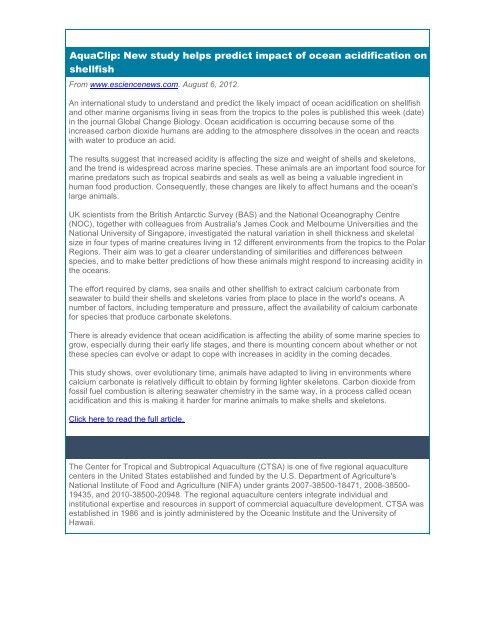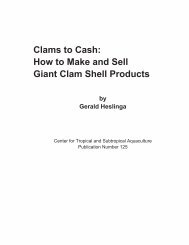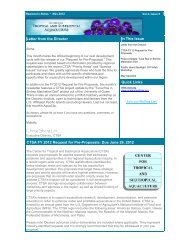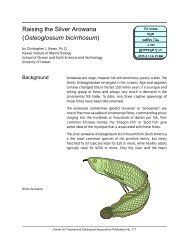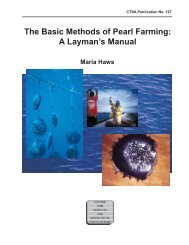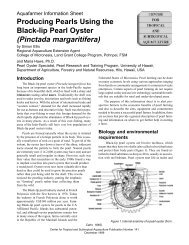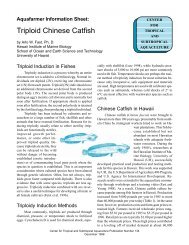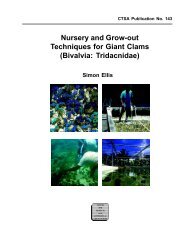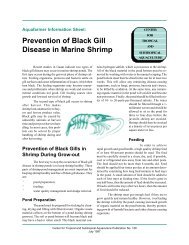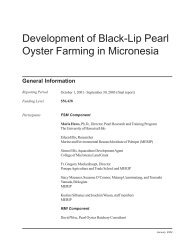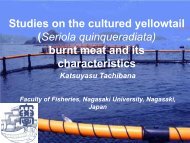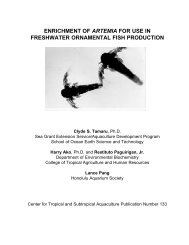Letter from the Director Cheng-Sheng Lee In This Issue ... - CTSA
Letter from the Director Cheng-Sheng Lee In This Issue ... - CTSA
Letter from the Director Cheng-Sheng Lee In This Issue ... - CTSA
Create successful ePaper yourself
Turn your PDF publications into a flip-book with our unique Google optimized e-Paper software.
AquaClip: New study helps predict impact of ocean acidification on<br />
shellfish<br />
From www.esciencenews.com. August 6, 2012.<br />
An international study to understand and predict <strong>the</strong> likely impact of ocean acidification on shellfish<br />
and o<strong>the</strong>r marine organisms living in seas <strong>from</strong> <strong>the</strong> tropics to <strong>the</strong> poles is published this week (date)<br />
in <strong>the</strong> journal Global Change Biology. Ocean acidification is occurring because some of <strong>the</strong><br />
increased carbon dioxide humans are adding to <strong>the</strong> atmosphere dissolves in <strong>the</strong> ocean and reacts<br />
with water to produce an acid.<br />
The results suggest that increased acidity is affecting <strong>the</strong> size and weight of shells and skeletons,<br />
and <strong>the</strong> trend is widespread across marine species. These animals are an important food source for<br />
marine predators such as tropical seabirds and seals as well as being a valuable ingredient in<br />
human food production. Consequently, <strong>the</strong>se changes are likely to affect humans and <strong>the</strong> ocean's<br />
large animals.<br />
UK scientists <strong>from</strong> <strong>the</strong> British Antarctic Survey (BAS) and <strong>the</strong> National Oceanography Centre<br />
(NOC), toge<strong>the</strong>r with colleagues <strong>from</strong> Australia's James Cook and Melbourne Universities and <strong>the</strong><br />
National University of Singapore, investigated <strong>the</strong> natural variation in shell thickness and skeletal<br />
size in four types of marine creatures living in 12 different environments <strong>from</strong> <strong>the</strong> tropics to <strong>the</strong> Polar<br />
Regions. Their aim was to get a clearer understanding of similarities and differences between<br />
species, and to make better predictions of how <strong>the</strong>se animals might respond to increasing acidity in<br />
<strong>the</strong> oceans.<br />
The effort required by clams, sea snails and o<strong>the</strong>r shellfish to extract calcium carbonate <strong>from</strong><br />
seawater to build <strong>the</strong>ir shells and skeletons varies <strong>from</strong> place to place in <strong>the</strong> world's oceans. A<br />
number of factors, including temperature and pressure, affect <strong>the</strong> availability of calcium carbonate<br />
for species that produce carbonate skeletons.<br />
There is already evidence that ocean acidification is affecting <strong>the</strong> ability of some marine species to<br />
grow, especially during <strong>the</strong>ir early life stages, and <strong>the</strong>re is mounting concern about whe<strong>the</strong>r or not<br />
<strong>the</strong>se species can evolve or adapt to cope with increases in acidity in <strong>the</strong> coming decades.<br />
<strong>This</strong> study shows, over evolutionary time, animals have adapted to living in environments where<br />
calcium carbonate is relatively difficult to obtain by forming lighter skeletons. Carbon dioxide <strong>from</strong><br />
fossil fuel combustion is altering seawater chemistry in <strong>the</strong> same way, in a process called ocean<br />
acidification and this is making it harder for marine animals to make shells and skeletons.<br />
Click here to read <strong>the</strong> full article.<br />
The Center for Tropical and Subtropical Aquaculture (<strong>CTSA</strong>) is one of five regional aquaculture<br />
centers in <strong>the</strong> United States established and funded by <strong>the</strong> U.S. Department of Agriculture's<br />
National <strong>In</strong>stitute of Food and Agriculture (NIFA) under grants 2007-38500-18471, 2008-38500-<br />
19435, and 2010-38500-20948. The regional aquaculture centers integrate individual and<br />
institutional expertise and resources in support of commercial aquaculture development. <strong>CTSA</strong> was<br />
established in 1986 and is jointly administered by <strong>the</strong> Oceanic <strong>In</strong>stitute and <strong>the</strong> University of<br />
Hawaii.


